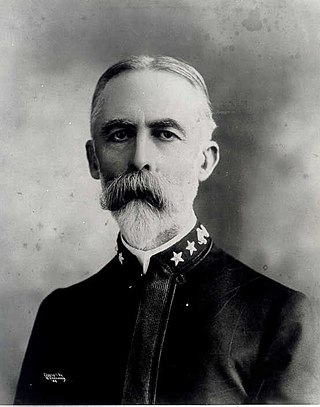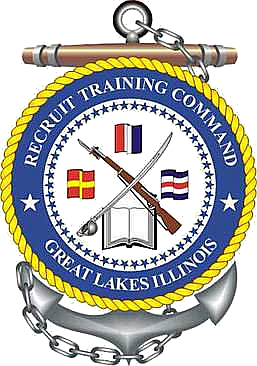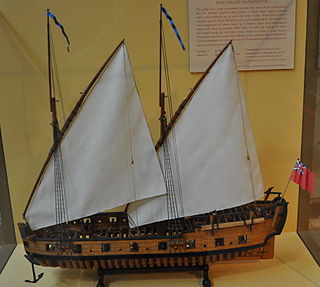
David Glasgow Farragut was a flag officer of the United States Navy during the American Civil War. He was the first rear admiral, vice admiral, and admiral in the United States Navy. He is remembered for his order at the Battle of Mobile Bay, usually paraphrased as "Damn the torpedoes, full speed ahead" in U.S. Navy tradition.

George Dewey was Admiral of the Navy, the only person in United States history to have attained that rank. He is best known for his victory at the Battle of Manila Bay during the Spanish–American War, with the loss of only a single crewman on the American side.
USS Washington may refer to:

The First Barbary War (1801–1805), also known as the Tripolitan War and the Barbary Coast War, was a conflict during the Barbary Wars, in which the United States and Sweden fought against Tripolitania. Tripolitania had declared war against Sweden and the United States over disputes regarding tributary payments made by both states in exchange for a cessation of Tripolitatian commerce raiding at sea. United States President Thomas Jefferson refused to pay this tribute. Sweden had been at war with the Tripolitans since 1800.

Captain Silas Talbot was an American military officer and slave trader. He served in the Continental Army and Continental Navy during the American Revolutionary War, and is most famous for commanding USS Constitution from 1799 to 1801. Talbot was a member of the Society of the Cincinnati's branch in New York.

Jacob Zeilin was the United States Marine Corps' first non-brevet flag officer. He served as the seventh commandant of the United States Marine Corps, from 1864 to 1876.

William Thomas Sampson was a United States Navy rear admiral known for his victory in the Battle of Santiago de Cuba during the Spanish–American War.

John Lorimer Worden was a U.S. Navy officer in the American Civil War, who took part in the Battle of Hampton Roads, the first-ever engagement between ironclad steamships at Hampton Roads, Virginia, on 9 March 1862.

Stephen Bleecker Luce was a U.S. Navy admiral. He was the founder and first president of the Naval War College, between 1884 and 1886.From 1909 to 1910 he was vice president,from 1910 to 1911 president of the Aztec Club of 1847.

James Lawrence was an officer of the United States Navy. During the War of 1812, he commanded USS Chesapeake in a single-ship action against HMS Shannon, commanded by Philip Broke. He is probably best known today for his last words, "Don't give up the ship!", uttered during the capture of the Chesapeake. The quotation is still a popular naval battle cry, and was invoked in Oliver Hazard Perry's personal battle flag, adopted to commemorate his dead friend.

George Wallace Melville was a United States Navy officer, engineer and Arctic explorer.
United States ship naming conventions for the U.S. Navy were established by congressional action at least as early as 1862. Title 13, section 1531, of the U.S. Code, enacted in that year, reads, in part,
The vessels of the Navy shall be named by the Secretary of the Navy under direction of the President according to the following rule: Sailing-vessels of the first class shall be named after the States of the Union, those of the second class after the rivers, those of the third class after the principal cities and towns and those of the fourth class as the President may direct.

The Recruit Training Command, Great Lakes, is a command unit within the United States Navy primarily responsible for conducting the initial orientation and indoctrination of incoming recruits, also known as boot camp and recruit training, or RTC. It is part of Naval Service Training Command. It is a tenant command of Naval Station Great Lakes in the city of North Chicago, Illinois, in Lake County, north of Chicago.

USS Martha Washington (ID‑3019) was a transport for the United States Navy during World War I named for Martha Washington, the first First Lady of the United States. She was originally ocean liner SS Martha Washington for the Austro-American Line before the war. Before and after her Navy service she was the United States Army transport USAT Martha Washington. The liner was sold to the Italian Cosulich Line in 1922. In 1932, when Cosulich was absorbed into Italia Flotte Riunite, the ship was renamed SS Tel Aviv. The ship was scrapped in 1934.

USS Washington was a large row galley, with a rowing crew of 60, that was placed into service under the control of the Continental Congress in 1776. During this age of sail, row galleys were highly maneuverable compared to sailing ships whose movements were dependent on the wind. Washington's war record consisted of an attack on several British warships, and, after finding itself on the losing side of the battle, the row galley rowed away, out of danger. There is no further report of her efforts for the Continental Navy.
USS Spitfire was a row galley authorized and constructed by Rhode Island during the American Revolution, and was placed in service in 1776 in the Rhode Island Navy. During this age of sail, row galleys were highly maneuverable compared to sailing ships whose movements were dependent on the wind. Spitfire had a reportedly successful career, helping to capture British cargo ships and engaging in the fight against British warships.

American colonial marines were various naval infantry units which served during the Revolutionary War on the Patriot side. After the conflict broke out in 1775, nine of the rebelling Thirteen Colonies established state navies to carry out naval operations. Accordingly, several marine units were raised to serve as an infantry component aboard the ships of these navies. The marines, along with the navies they served in, were intended initially as a stopgap measure to provide the Patriots with naval capabilities before the Continental Navy reached a significant level of strength. After its establishment, state navies, and the marines serving in them, participated in several operations alongside the Continental Navy and its marines.

HMS Phoenix was a 44-gun fifth-rate ship of the Royal Navy. She was launched in 1759 and sunk in 1780 and saw service during the American War of Independence.














